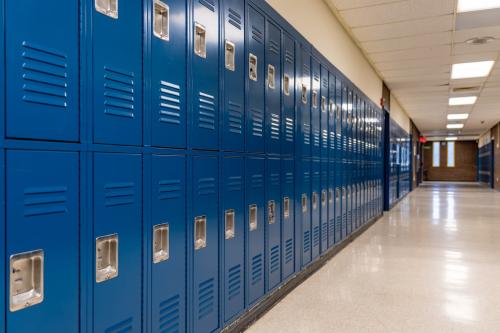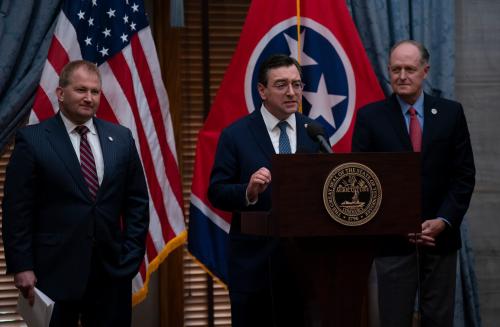This is part of the “Why we have and need a US Department of Education” series, which seeks to examine the role of the U.S. Department of Education at a time when the president of the United States has called for the Department’s demise. It considers what the Department does to shape education policy and practice in the United States. It also addresses misconceptions about the Department’s role and the president’s authority to dismantle it.
On March 20, President Trump signed a long-awaited executive order (EO) to “facilitate the closure of the Department of Education.” The EO directs the Secretary of Education to act aggressively, within the law, to dismantle the U.S. Department of Education (ED).
In this piece, Brown Center scholars reproduce the full text of the EO and provide commentary with context and analysis.
“By the authority vested in me as President by the Constitution and the laws of the United States of America, and to enable parents, teachers, and communities to best ensure student success, it is hereby ordered:
Section 1. Purpose and Policy. Our Nation’s bright future relies on empowered families, engaged communities, and excellent educational opportunities for every child. Unfortunately, the experiment of controlling American education through Federal programs and dollars — and the unaccountable bureaucracy those programs and dollars support — has plainly failed our children, our teachers, and our families.”
Primary decision-making power over education already belongs to families, their local communities, and states, as it always has. The U.S. Constitution says nothing about schools, leaving education policy up to state and local governments. The federal government plays a narrowly defined role in the U.S. education system—namely providing funding, enforcing federal civil rights law, and facilitating research and development. Notably, federal law explicitly prohibits the federal government from exerting control over school curriculum, operations, or staffing.
“Taxpayers spent around $200 billion at the Federal level on schools during the COVID-19 pandemic, on top of the more than $60 billion they spend annually on Federal school funding. This money is largely distributed by one of the newest Cabinet agencies, the Department of Education, which has existed for less than one fifth of our Nation’s history.”
These historical claims omit important context. As noted on ED’s website, President Andrew Johnson created a cabinet-level Department of Education in 1867. It was quickly “demoted to an Office of Education in 1868” and existed continuously for more than a century under various cabinet-level departments before its 1979 restructuring as the current form of ED. Inclusive of this earlier history, the federal government has administered funding and other educational programs in some capacity for over 150 years.
“The Congress created the Department of Education in 1979 at the urging of President Jimmy Carter, who received a first-ever Presidential endorsement from the country’s largest teachers’ union shortly after pledging to the union his support for a separate Department of Education. Since then, the Department of Education has entrenched the education bureaucracy and sought to convince America that Federal control over education is beneficial. While the Department of Education does not educate anyone, it maintains a public relations office that includes over 80 staffers at a cost of more than $10 million per year.”
Though not explicit, the text here suggests that teachers’ unions are an entrenched interest that has captured ED and usurped local control of education. This suggestion is misleading. As described above, federal law prohibits ED from directing many aspects of public schooling, including staffing. Except for schools operated by the Department of Defense or Bureau of Indian Education, all other K-12 public school teachers are employees of state agencies or authorized affiliates. ED does not set teacher licensure requirements, staffing levels, or compensation schedules; rather, these are state and local functions. Prior research has shown teachers’ unions do exert influence over education policymaking, though this influence is primarily focused at state and local levels. It is unclear how dismantling ED would affect union influence, if at all.
“Closing the Department of Education would provide children and their families the opportunity to escape a system that is failing them. Today, American reading and math scores are near historical lows. This year’s National Assessment of Educational Progress showed that 70 percent of 8th graders were below proficient in reading, and 72 percent were below proficient in math. The Federal education bureaucracy is not working.”
This executive order, and the rhetoric surrounding it, takes liberties to present U.S. student performance in a particularly (and misleadingly) negative light. First, the NAEP’s long-term trend (LTT) assessments, which allow for comparisons across time, show gains in student performance from the 1970s until the present day (despite concerning declines over the last few years). Those gains are evident across multiple grades and subjects. Second, NAEP’s standard for “proficiency” is very high—and, as such, prone to rhetorical exploitation. Third, it would be extremely difficult to identify the effects of the U.S. Department of Education, itself, on student learning. We don’t know of any rigorous studies that claim to do so. Relatedly, it’s worth emphasizing that most of the Department’s spending goes to higher education (e.g., the student loan program), with federal funding accounting for only about 10% of K-12 school spending.
“Closure of the Department of Education would drastically improve program implementation in higher education. The Department of Education currently manages a student loan debt portfolio of more than $1.6 trillion. This means the Federal student aid program is roughly the size of one of the Nation’s largest banks, Wells Fargo. But although Wells Fargo has more than 200,000 employees, the Department of Education has fewer than 1,500 in its Office of Federal Student Aid. The Department of Education is not a bank, and it must return bank functions to an entity equipped to serve America’s students.”
The Higher Education Act authorized the federal student loan program, recognizing that private banks would never have an incentive to offer sufficient or fair student loans to income-constrained students. When private banks do offer student loans, many engage in illegal loan management practices, such as incorrectly charging late fees, failing to update borrowers’ credit reports, and using illegal practices to collect outstanding debt. This raises serious questions about how private banks would serve America’s students, particularly with the recent attempts to dismantle the Consumer Financial Protection Bureau, which has served as a watchdog for unscrupulous student loan practices.
It’s true that the federal student loan program needs additional resources and reform. As the EO notes, private companies typically allocate significantly more resources toward managing such a large financial portfolio. The Federal Student Aid (FSA) office has been historically understaffed. Recent reductions in force at ED have almost halved the office, exacerbating the challenges of effectively administering the student loan program or federal financial aid. The Trump administration has made it clear they do not actually intend to move those functions out of ED (since doing so would require congressional action). What the administration can do is continue to kneecap FSA, resulting in worse customer service and threatening students’ ability to access financial aid and successfully repay their loans.
“Ultimately, the Department of Education’s main functions can, and should, be returned to the States.
Sec. 2. Closing the Department of Education and Returning Authority to the States. (a) The Secretary of Education shall, to the maximum extent appropriate and permitted by law, take all necessary steps to facilitate the closure of the Department of Education and return authority over education to the States and local communities while ensuring the effective and uninterrupted delivery of services, programs, and benefits on which Americans rely.”
There might not be a more important phrase in this executive order than “to the maximum extent appropriate and permitted by law.” ED was created by an act of Congress, the Department of Education Organization Act (1979). That same legislation established several offices and officers within ED, along with assigning specific responsibilities to the Department. This means that eliminating ED entirely—or eliminating or moving many of its key functions—would require another act of Congress. The Trump administration would need to overcome major political hurdles, including a potential Senate filibuster, to achieve this goal. It would confront similar obstacles if it sought to make structural changes to widely supported federal laws or programs, such as the Individuals with Disabilities Education Act, Title I of the Elementary and Secondary Education Act, and the Federal Pell Grant program.
Still, it’s clear the Trump administration plans to aggressively work to reduce ED’s size and impact. This includes making dramatic staffing changes, as we saw recently, that will affect ED’s ability to fulfill its core responsibilities.
“(b) Consistent with the Department of Education’s authorities, the Secretary of Education shall ensure that the allocation of any Federal Department of Education funds is subject to rigorous compliance with Federal law and Administration policy, including the requirement that any program or activity receiving Federal assistance terminate illegal discrimination obscured under the label “diversity, equity, and inclusion” or similar terms and programs promoting gender ideology.”
The EO’s emphasis on the Department’s authority to ensure federally funded programs are not engaged in illegal discrimination in the form of promoting “diversity, equity, and inclusion” or “gender ideology” is noteworthy. That’s because the Trump administration has taken unprecedented and unconstitutional steps to weaponize ED’s authority to enforce federal civil rights laws. This section of the executive order indicates the administration’s intention to continue down that path.
To date, the administration’s approach has included redirecting much of the federal government’s enforcement work toward undermining local efforts to promote equity for transgender youth and students from historically racially and ethnically marginalized groups. To do so, the administration has: a) unlawfully attempted to redefine as illegal racial discrimination any race-conscious initiatives, including DEI programs; and b) promoted an interpretation of Title IX’s prohibitions on sex-based discrimination that frames any accommodations for transgender students as discrimination against girls and women.
In addition, it has sidestepped the traditionally lengthy, detailed investigation process to issue rulings and punishments almost immediately. These punishments include withholding federal funds for potential civil rights violations. Whereas past administrations’ investigations might lead to negotiated settlement agreements with institutions, the Trump administration has moved quickly to withhold vast amounts of funding from institutions—as it did with Columbia University, for example—seemingly undeterred by the illegality of preemptive termination of funding, or the possibility that its actions will punish students, staff, or faculty who had nothing to do with the supposed violation.
“Sec. 3. General Provisions. (a) Nothing in this order shall be construed to impair or otherwise affect:
(i) the authority granted by law to an executive department or agency, or the head thereof; or
(ii) the functions of the Director of the Office of Management and Budget relating to budgetary, administrative, or legislative proposals.
(b) This order shall be implemented consistent with applicable law and subject to the availability of appropriations.
(c) This order is not intended to, and does not, create any right or benefit, substantive or procedural, enforceable at law or in equity by any party against the United States, its departments, agencies, or entities, its officers, employees, or agents, or any other person.”
This section of “General Provisions” contains the same legal language as other Trump executive orders. However, a couple of points specific to this order’s context are worth noting. First, Secretary McMahon acknowledged during her Senate confirmation hearing that the Trump administration cannot shut down the U.S. Department of Education unilaterally. Doing so, she said, would require congressional action. Second, if the Trump administration takes a more aggressive approach than what the law seems to allow, its actions almost certainly will be challenged in court (if not walked back by the Trump administration before it reaches that point).
The Brookings Institution is committed to quality, independence, and impact.
We are supported by a diverse array of funders. In line with our values and policies, each Brookings publication represents the sole views of its author(s).











Commentary
Brookings scholars analyze Trump’s order to dismantle the Department of Education
March 21, 2025